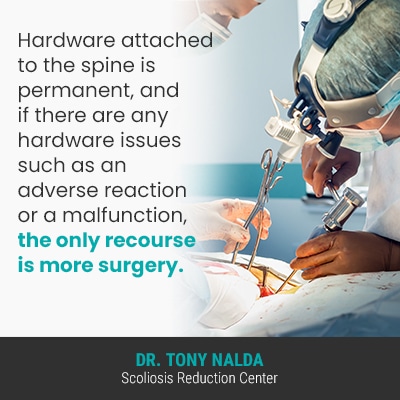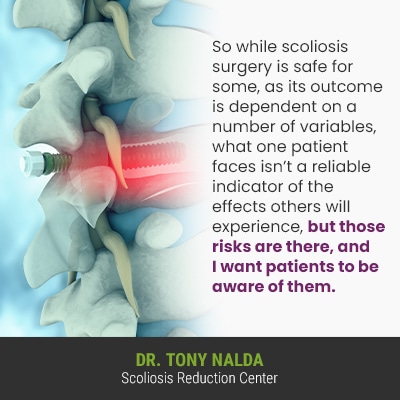There are risks associated with any surgical procedure, but as the brain and spine work in tandem to form the body’s central nervous system, spinal fusion surgery comes with some serious potential side effects and risks that should be considered carefully.
Scoliosis can be treated surgically, but the reality is that most cases can be treated nonsurgically, and while all surgical procedures come with their share of risks, scoliosis surgery can cost the spine in terms of its natural strength and function.
Before moving on to discussing the general procedure of spinal fusion, let’s first address some important condition features.
Scoliosis
People with scoliosis have developed an unnatural sideways spinal curve, with rotation, making it a 3-dimensional condition.
The spine’s natural and healthy curves make it stronger, more flexible, and better able to absorb/distribute mechanical stress incurred during movement, so when a spinal condition causes a loss of one or more of the spine’s healthy curves, the spine is no longer aligned.
The spine consists of vertebrae stacked on top of one another in a straight and neutral alignment, and in order for the spine to function optimally, it has to maintain its natural curves and alignment.
When the spine is not aligned, its biomechanics are disrupted, and as a progressive condition, scoliosis has it in its nature to worsen over time, which is why being proactive with treatment is so important.
In addition to being progressive, scoliosis is highly variable, meaning no two cases are the same; the condition can range from mild to moderate and severe to very severe, and when it comes to scoliosis surgery, condition severity is a key factor:
Mild scoliosis: Cobb angle measurement of between 10 and 25 degrees
Moderate scoliosis: Cobb angle measurement of between 25 and 40 degrees
Severe scoliosis: Cobb angle measurement of 40+ degrees
Very-severe scoliosis: Cobb angle measurement of 80+ degrees
Condition severity is determined by a measurement known as Cobb angle, and for those undergoing traditional scoliosis treatment, it’s when a condition progresses into the severe classification that patients become surgical candidates.
So now that we’ve covered some important condition features, let’s explore the general procedure of spinal fusion, followed by answering some common surgery-related questions.
Scoliosis Surgery
Officially known as spinal fusion surgery, scoliosis surgery attempts to stop the condition from progressing, but the way in which this is achieved can have some negative effects.
While there are different types of spinal fusion surgery, generally, the procedure involves fusing the most-tilted vertebrae of the spine, at the curve’s apex, into one solid bone, and then rods are attached to the spine with pedicle screws to hold it in place.

Hardware attached to the spine is permanent, and if there are any hardware issues such as an adverse reaction or a malfunction, the only recourse is more surgery.
In most cases, in the section of the spine being fused, its intervertebral discs, that sit between adjacent vertebrae to provide cushioning, flexibility, structure, and act as the spine’s shock absorbers, are removed.
The goal of spinal fusion is to eliminate movement in that section of the spine so the vertebrae can’t become more tilted over time: stopping progression.
It is important to note, however, that there are no guarantees that progression won’t continue, and once a spine is fused, it’s fused for life.
So now that we know how the procedure is performed, let’s talk about risks by answering some common questions.
How Bad is Scoliosis Surgery?
When I’m asked by patients, and their families, how bad scoliosis surgery is, what they want to know is how dangerous it is, what types of risks there are, potential side effects, complications, etc.
Here at the Scoliosis Reduction Center®, I offer patients a nonsurgical treatment approach, but that doesn’t mean I’m not willing to spend time discussing both the scoliosis surgery benefits, and scoliosis surgery cons; in fact, this is what I want most for my patients, for them to be informed so they can make the best possible decision when it comes to treatment.
When it comes to the risks associated with spinal fusion, the answer differs for each patient.
Remember, scoliosis ranges widely in severity, and there are different condition types, sections of the spine that can be affected, and scoliosis affects all ages.
Location of the fused spinal section, condition severity, patient age and overall health, and the number of vertebrae fused all shape how a patient is going to respond to the surgery, both in the short and long term.
When it comes to the risks of spinal fusion, I like to divide the topic into two categories: risks associated with the procedure itself and associated long-term effects of the surgical treatment.
So is scoliosis surgery safe? While scoliosis surgery can help straighten a scoliotic spine, the procedure itself is invasive and is associated with the following risks:
- Excessive blood loss
- Nerve damage
- Adverse reaction to hardware used
- Pain at the fusion site
- The need for subsequent surgeries

So while scoliosis surgery is safe for some, as its outcome is dependent on a number of variables, what one patient faces isn’t a reliable indicator of the effects others will experience, but those risks are there, and I want patients to be aware of them.
Now, when it comes to the long-term effects of spinal fusion, these are what concern me the most because they have the potential to impact overall quality of life, and in addition, there are some questions we don’t have the answers to.
Can Scoliosis Surgery Go Wrong?
When patients ask me if scoliosis surgery is safe, if it can go wrong, a part of this question is referencing the procedure itself, and another is referring to its potential long-term effects.
The reality is that there is a gap in the research/data on the extensive long-term effects of 30, 40, 50+ years down the road, and the reality is that putting any foreign element inside the body is risky: that element can deteriorate and/or fail.
When it comes to rods, screws, and hooks commonly used in spinal fusion, what’s their lifespan? When do they start to deteriorate, increasing the likelihood of a malfunction (rod breaking, cracking, screw coming loose), and remember scoliosis affects all ages, and is most prevalent in adolescents; the younger the patient, the longer that hardware has to last.
So to address the question of if scoliosis surgery can go wrong, in terms of short-term effects, there are potential risks, and in terms of its long-term effects, I’ve spoken with a number of patients who regret their choice to undergo surgery, particularly without trying a less-invasive treatment method first.
Again, while each patient’s experience of life with a fused spine will be unique, following are some of the long-term effects associated with spinal fusion:
- Increased levels of back pain
- Nerve damage and radicular pain
- Hardware failure/deterioration over time
- A spine that’s weaker and more vulnerable to injury
- Disappointing cosmetic results
- Psychological effect of living with a fused spine
- Loss of spinal flexibility and range of motion
I listed a loss of spinal flexibility and range of motion last because, in my experience, this is an outcome many patients don’t expect and find the most disappointing.
The level of flexibility loss will depend, again, on a number of factors, some of the most important being patient age, condition severity, location of, and the number of, vertebrae fused.
As multiple vertebrae are fused together and the spine is held artificially in place, it’s common that the fused section can feel increasingly tight and sore, and this also affects the spine’s surrounding muscles that can become weak, sore, and painful.
The very design of the spine is based on movement, with all of its complex structures working together to facilitate flexibility and range of motion, so when the spine’s discs are removed and/or vertebral bodies are fused together, it’s not going to be as strong or function in the same way.
So scoliosis surgery side effects can be minimal for some, and severe for others, just as the condition itself can range from mild to very severe, depending on a number of variables that change from patient to patient.
Conclusion
While scoliosis surgery benefits can include preventing a condition from worsening, the way in which it’s achieved can impact a person’s quality of life.
A spine that’s less moveable and flexible can mean certain activity restrictions, and as a fused spine is more vulnerable to injury, that knowledge can carry a heavy emotional weight.
Many patients have also expressed disappointment in their level of back pain post-surgery because, again, the unnatural and invasive treatment, is contrary to the spine’s natural design and function, and this can make the spine and its surrounding muscles excessively stiff, sore, and weak.
So is scoliosis surgery dangerous? Any surgery is dangerous in terms of potential risks, side effects, and complications, and spinal fusion is no exception.
For those looking for guidance on scoliosis treatment options and/or are wanting to forego a surgical recommendation in favor of a less-invasive more-natural conservative treatment option, answers and proactive treatment are within reach.




